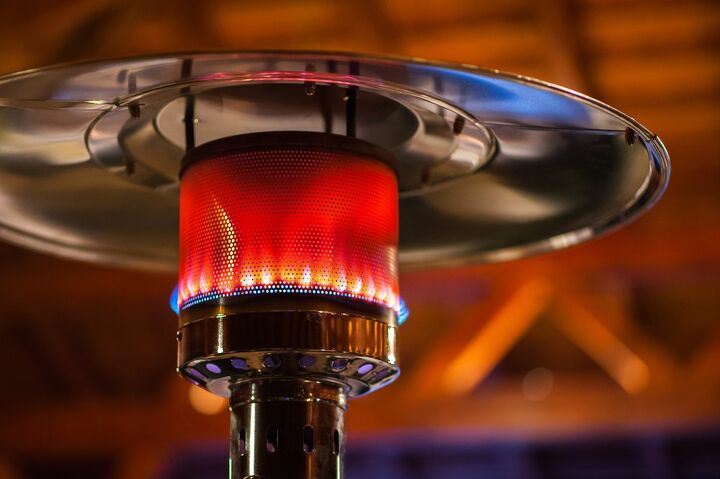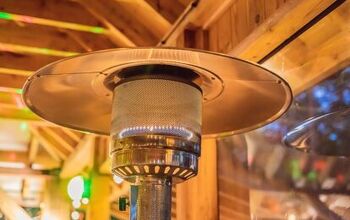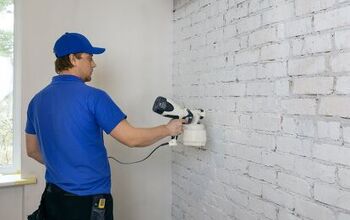Can You Use Patio Heaters Indoors? (Find Out Now!)

When the weather cools off, it can be tempting to use portable heaters as an addition heat source in your home. There are countless types of indoor heaters that you can place in any room throughout your home.
That said, many homeowners turn toward the patio heaters they already have instead of going out to buy a separate indoor heater. This begs the question: Is this really a good idea?
The short answer: No, you absolutely should never use an outdoor patio heater indoors for many reasons. You shouldn’t even use electrical patio heaters indoors. Patio heaters run much hotter than their indoor counterparts, have a low center of gravity, can emit harmful gases, and pose a serious fire hazard, too.
Let’s dive a bit deeper into the issue, so you can truly understand the serious risks of using a patio heater indoors.
Do You Need a Heating and Cooling Contractor?
Get free, zero-commitment quotes from pro contractors near you.

About Outdoor Patio Heaters
Patio heaters are not designed the same as indoor heaters for one simple reason: it would make them cost way more for no reason. Outdoor heaters are much simpler in design, which is just one reason why they should be kept outside. However, some can be used under covered patios.
Most patio heaters function by using radiant heat. When the unit heats to a specific temperature, it will automatically emit that heat through electromagnetic waves that are in the infrared range. There are some patio heaters that use the convection process instead of radiation. During this process, electricity moves through a resistor, which converts it into heat energy.
Risks of Using Outdoor Heaters Indoors
Patio heaters are made specifically to be used outdoors. This means they can pose serious issues when placed in an enclosed space. For starters, the shape and size of outdoor heaters often make it difficult to move them around and stabilize them in a cramped area.
They are usually thinner and taller, so they don’t take up as much space while still being able to emit a lot of heat. For this reason, you will often run into clearance issues as far as ceiling heights go. Indoor heaters, on the other hand, are generally smaller and designed to be more portable.
Finally, any type of heater needs ventilation, and there typically isn’t much inside. This is especially true if you’re already trying to warm your space with a heater. Odds are, there won’t be any windows open!
Carbon Monoxide Poisoning
If you have a natural gas or propane heater, you run the risk of a gas leak. This can be potentially dangerous outside but can turn downright fatal in an enclosed space. Propane gas heaters produce carbon monoxide, nitrogen dioxide, and nitric oxide, all of which can be fatal when inhaled in large amounts.
When compared to indoor heaters, the standards for these emission levels are much looser for patio heaters since they are meant to be used in open spaces. They end up releasing more of these gases, which will circulate throughout a house if the heater is indoors.
The best cause scenario is these emissions cause some coughing and general discomfort. Worst case is they cause suffocation and death. Carbon monoxide poisoning is the #1 risk of using outdoor heaters indoors. These symptoms include:
- Severe Headaches
- Nausea & Vomiting
- Shortness of Breath
- Loss of Consciousness
Fire and Explosion Risks
Outdoor patio heaters are designed to burn much hotter than their indoor counterparts, which makes them all the more dangerous when used in an enclosed space. Plus, natural gas and propane heaters run the risk of a gas leak, which is not only harmful to breath in, but can also lead to a serious fire or even an explosion.
Types of Patio Heaters
Patio heaters can be categorized based on how they provide heat: natural gas, propane, or electricity. Each type comes with its own set of benefits and drawbacks, so it’s important to know how they work. It’s also important to note that infrared heaters can be powered by any of these three sources.
Whichever you choose for your yard, you should never use them indoors. Here’s why:
Natural Gas Patio Heaters
Natural gas heaters are connected directly to your gas line to offer continuous heat, which means they are not particularly portable. Since these types of heaters give off fumes, you will want to use them in wide open spaces, so any harmful byproducts can safely dissipate instead of getting trapped in a room.
Propane Patio Heaters
Propane heaters are portable because they are attached to a propane tank, which makes them a convenient choice for many homes. That said, you should never move them inside for use. This is because they pose the risk of a gas leak and carbon monoxide poisoning among other things.
There are two common types of propane patio heaters: standing and tabletop. The former is great for patios of all shapes and sizes while the latter is best suited for more intimate settings. Again, just make sure those settings are outdoors.
Electric Patio Heaters
Electric patio heaters are also portable and convenient for outdoor use. These types of heaters are safer to use in smaller, less-ventilated patios. It’s true that some sources say you can get away with using electric outdoor heaters inside, but the truth is you really shouldn’t risk it. At the end of the day, we call them “outdoor heaters” for a reason.
There are a handful of different types of electric patio heaters, including:
- Hanging
- Umbrella-Mounted
- Wall-Mounted
- Standing
Related Questions
Are there heaters for both indoor and outdoor use?
Yes, there are specific heaters that you can use for both indoors and outdoors. To avoid any potential mishaps, these may be the best investment for your home.
Can I use an indoor heater outside?
Technically you can use your indoor heaters outside, but it won’t be the most effective solution. Indoor heaters will not get as hot as outdoor heaters and they are not as resistant to the elements either. On a milder night, however, it could work for a smaller gathering.
Do You Need a Heating and Cooling Contractor?
Get free, zero-commitment quotes from pro contractors near you.

Conclusion
At the end of the day, it’s really not worth attempting to use an outdoor patio heater indoors. Risk factors can range from minor to severe depending on the size and layout your space, but the fact is it still poses a risk. Instead, invest in an indoor heater or one that is rated for both inside and out.

I am a copywriter and editor based in the Las Vegas area with nearly a decade of experience under my belt writing landing pages, cost guides, blog posts, newsletters, case studies, and social media content. I have a degree in Strategic Communication and experience working in both the account and creative spheres. My goal is to always be discovering new interests and bettering myself as a writer and editor along the way.
More by Kerry Souder



















![How To Reset A Whirlpool Cabrio Washer [In 5 Easy Steps!]](https://cdn-fastly.upgradedhome.com/media/2023/07/31/9076531/how-to-reset-a-whirlpool-cabrio-washer-in-5-easy-steps.jpg?size=350x220)







